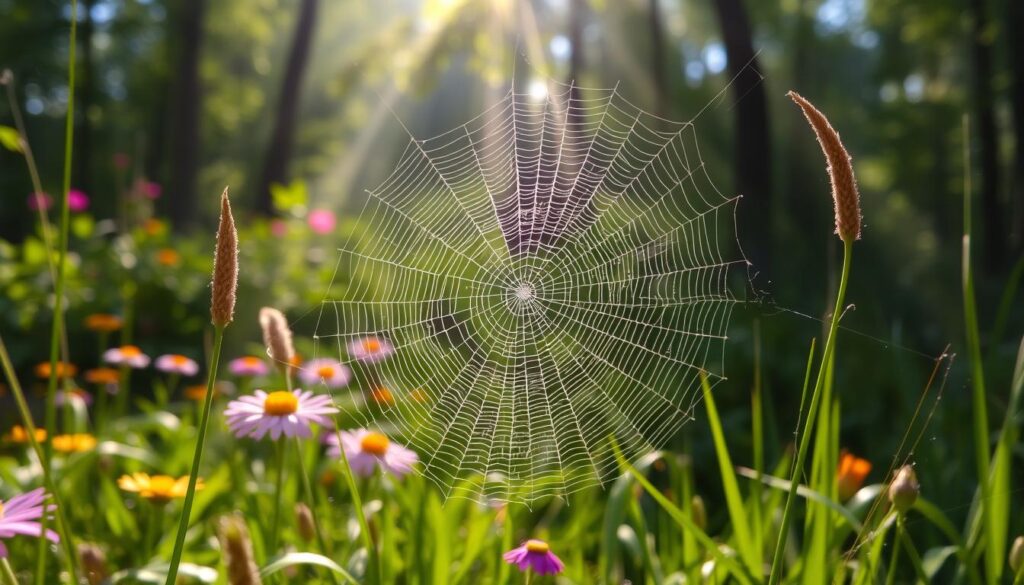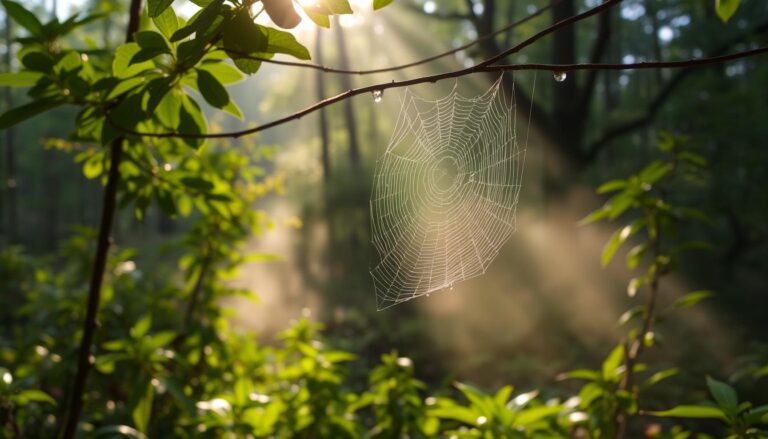Lesy ad spiderweb formations are truly amazing natural wonders. They show the detailed beauty of forest ecosystems. These wonders can be seen all over the world, showing how vital it is to protect our environment. The unique shapes of lesy and spiderweb amaze us. They remind us of nature’s incredible power. They encourage us to learn more about these natural marvels.
Exploring lesy ad spiderweb helps us see their role in forest ecosystems. The patterns and designs come from spiders and other creatures’ adaptability. Studying lesy and spiderweb teaches us to appreciate nature’s beauty. It also gives us insights into forest ecosystems. By learning about these formations, we understand why preserving nature is so important.
The Magic of Lesy ad Spiderweb Formations
Spider web formations have amazed humans for centuries. These intricate webs show the amazing skills of spiders. You can find them in forests and grasslands, playing a key role in the ecosystem.
Weather greatly affects spider webs. Spiders build their webs in calm, dry air, making them strong. But rain or strong winds can ruin them, forcing spiders to start over.
Understanding Natural Web Patterns
There are different types of spider webs, like orb, sheet, and cobwebs. Each type fits the spider’s needs and where it lives. For example, orb webs catch flying insects, while sheet webs trap crawling ones.

When and Where to Find These Displays
You can spot spider webs in forests, grasslands, and cities. The best times are early morning or late evening. Look for them in national parks, nature reserves, or even your backyard.
The Role of Weather Conditions On Lesy ad spiderweb
Weather is key for spider webs. Spiders adjust their webs based on temperature and humidity. Heavy rain or strong winds might make them stop building or lose their webs.
| Weather Condition | Effect on Spider Webs |
|---|---|
| Heavy Rain | Damage or destruction of webs |
| Strong Winds | Damage or destruction of webs |
| High Humidity | Increased web-building activity |
| Low Temperature | Reduced web-building activity |
Dawn’s Dance: Morning Dew on Forest Webs
As the sun rises over forest ecosystems, a serene and enchanting atmosphere unfolds. The morning dew gently settles on the intricate webs, highlighting their delicate details. This creates a breathtaking spectacle. It’s a haven for wildlife photography enthusiasts, who seek to capture nature’s splendor.
In this fleeting moment, the forest comes alive with dew-kissed webs. The soft, golden light of dawn casts a warm glow on the forest floor. It illuminates the intricate patterns and shapes of the webs. As the morning dew evaporates, the webs seem to dance in the gentle breeze, creating a mesmerizing display of natural wonder.
For those who venture into the forest at dawn, the experience is magical. The stillness of the morning air, the sweet songs of birds, and the gentle rustle of leaves all combine. They create an immersive experience that awakens the senses. And for wildlife photography enthusiasts, this moment offers a unique opportunity to capture the beauty of forest ecosystems in all their glory.
To make the most of this experience, it’s essential to be prepared. Here are a few tips for capturing the beauty of morning dew on forest webs:
- Arrive early to catch the dawn light and the peak of dew formation
- Use a macro lens to capture the intricate details of the webs
- Experiment with different angles and compositions to add depth and interest to your photos
By embracing the beauty of forest ecosystems and the magic of morning dew, we can gain a deeper appreciation for the natural world. And for wildlife photography enthusiasts, this experience offers a unique opportunity. It allows us to capture the essence of nature’s splendor and share it with the world.
The Artistic Architecture of Spider Webs in Nature
Spider webs are amazing examples of natural engineering. They show intricate geometric patterns that show the math skills of their makers. Different spiders have their own web designs, from the classic orb web to complex sheet webs and cobwebs.
Spider webs use geometric patterns for both function and beauty. These patterns help attract prey, defend against predators, and even talk to other spiders. The math in spider webs shows how clever and adaptable these tiny creatures are.
Geometric Patterns in Web Design
Spider webs feature many geometric patterns, like spirals, circles, and triangles. These patterns are mixed to create stunning designs. For instance, the European garden spider’s orb web has a spiral pattern. This helps spread out stress and strain in the web.
Different Web Types and Their Purposes – Lesy ad spiderweb
Spiders use various webs for different reasons. The golden orb spider has a big, orb-shaped web to catch prey. On the other hand, the wolf spider uses a small, compact web to surprise its prey. Knowing about these webs helps us understand spider behavior and their place in nature.
Nature’s Mathematical Precision
Spider webs are a great example of natural engineering’s math skills. They can handle strong winds and other challenges thanks to their detailed patterns and math. This shows how smart and adaptable spiders are, inspiring human designers and engineers.
Seasonal Changes and Web Formation – Lesy ad spiderweb
As seasons change, Lesy and Spiderweb’s formation and life span are greatly affected. Environmental conservation is key to keeping their habitats safe. The amount of food spiders have changes with the seasons, affecting their web-building.
The effects of seasonal changes on web-making are many. In spring and summer, spiders have plenty of insects to eat. This makes it easy for them to build and fix their webs. But, in winter, there’s less food, so spiders must be clever with their webs.
Weather also plays a big role. Spiders adjust their webs to handle strong winds and heavy rain.
Some important things that change with the seasons include:
- Food availability: How many insects there are affects spiders’ web-building.
- Weather conditions: Spiders change their webs to deal with bad weather.
- Habitat preservation: Environmental conservation helps keep places where Lesy and Spiderweb can live.
In summary, the link between seasonal changes, web formation, and environmental conservation is vital for Lesy and Spiderweb’s survival. By understanding these connections, we can help protect these natural wonders for the future.
Photography Tips for Capturing Web Beauty – Lesy ad spiderweb
Wildlife photography is all about technical skills and patience when capturing Lesy and Spiderweb formations. Understanding camera settings and lighting techniques is key. Adjusting your camera settings can make the webs stand out, revealing their natural beauty.
Lighting is crucial for stunning web images. Natural light is best in the early morning or late afternoon. It’s soft and warm, enhancing the webs’ beauty. A polarizing filter can also reduce glare and boost colors.
- Use a macro lens to get up close and personal with the webs
- Adjust your camera settings to suit the environment, taking into account factors such as aperture, shutter speed, and ISO
- Experiment with different lighting techniques to find what works best for your shot
- Pay attention to composition, considering factors such as leading lines, symmetry, and framing
By following these tips and honing your wildlife photography skills, you can capture the intricate beauty of Lesy and Spiderweb formations. This showcases the amazing details of these natural wonders.
Conclusion: Embracing Nature’s Delicate Artistry
Exploring Lesy and Spiderweb formations shows us nature’s amazing side. These art pieces in the environment are truly special. We’ve seen how spider webs are both beautiful and mathematically perfect, showing off the spiders’ incredible skills.
By loving these natural wonders, we learn to respect our planet more. These short-lived sights teach us about nature’s balance. They also show us why we must protect our world’s beauty.
Let’s keep the lessons from Lesy and Spiderweb formations in mind. They inspire us to explore and protect our world’s beauty. This way, we make sure these amazing sights will continue to amaze and inspire future generations.
FAQ’s About Lesy ad spiderweb
What are Lesy and Spiderweb?
Lesy and Spiderweb are amazing natural sights found in forests. They show intricate web-like patterns made by nature.
Where can I find these natural wonders?
You can find Lesy and Spiderweb in forested areas. They are best seen early in the morning when dew makes them stand out.
What role do weather conditions play in the formation of Lesy and Spiderweb?
Weather like humidity, temperature, and wind is key. It helps create and keep Lesy and Spiderweb looking their best.
How can I capture the beauty of Lesy and Spiderweb through photography?
To capture their beauty, use the right camera settings and lighting. Also, follow composition guidelines to show off their details and natural beauty.
What is the role of spiders in the formation of these natural wonders?
Spiders are crucial in making Lesy and Spiderweb. They use their skills and math to build these stunning natural displays.
How do seasonal changes affect the formation of Lesy ad Spiderweb?
Changes in temperature, humidity, and resources affect Lesy and Spiderweb. These changes show how these wonders and their environment are connected.
How can we help protect and preserve these natural spectacles?
We can help by being responsible and respectful in our photography. Also, supporting environmental conservation is key to protecting their habitats.


